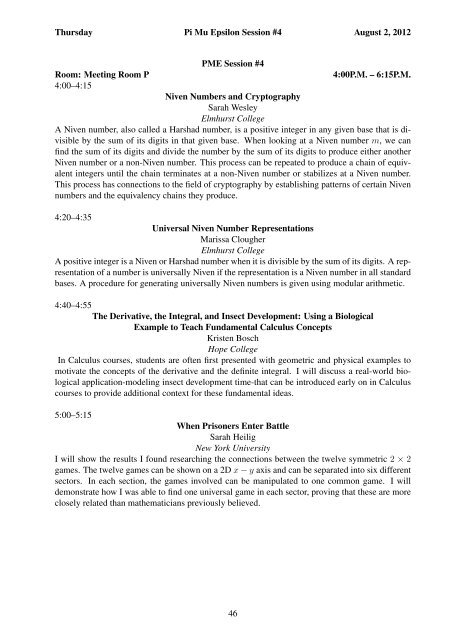Pi Mu Epsilon - Mathematical Association of America
Pi Mu Epsilon - Mathematical Association of America
Pi Mu Epsilon - Mathematical Association of America
Create successful ePaper yourself
Turn your PDF publications into a flip-book with our unique Google optimized e-Paper software.
Thursday <strong>Pi</strong> <strong>Mu</strong> <strong>Epsilon</strong> Session #4 August 2, 2012<br />
PME Session #4<br />
Room: Meeting Room P<br />
4:00P.M. – 6:15P.M.<br />
4:00–4:15<br />
Niven Numbers and Cryptography<br />
Sarah Wesley<br />
Elmhurst College<br />
A Niven number, also called a Harshad number, is a positive integer in any given base that is divisible<br />
by the sum <strong>of</strong> its digits in that given base. When looking at a Niven number m, we can<br />
find the sum <strong>of</strong> its digits and divide the number by the sum <strong>of</strong> its digits to produce either another<br />
Niven number or a non-Niven number. This process can be repeated to produce a chain <strong>of</strong> equivalent<br />
integers until the chain terminates at a non-Niven number or stabilizes at a Niven number.<br />
This process has connections to the field <strong>of</strong> cryptography by establishing patterns <strong>of</strong> certain Niven<br />
numbers and the equivalency chains they produce.<br />
4:20–4:35<br />
Universal Niven Number Representations<br />
Marissa Clougher<br />
Elmhurst College<br />
A positive integer is a Niven or Harshad number when it is divisible by the sum <strong>of</strong> its digits. A representation<br />
<strong>of</strong> a number is universally Niven if the representation is a Niven number in all standard<br />
bases. A procedure for generating universally Niven numbers is given using modular arithmetic.<br />
4:40–4:55<br />
The Derivative, the Integral, and Insect Development: Using a Biological<br />
Example to Teach Fundamental Calculus Concepts<br />
Kristen Bosch<br />
Hope College<br />
In Calculus courses, students are <strong>of</strong>ten first presented with geometric and physical examples to<br />
motivate the concepts <strong>of</strong> the derivative and the definite integral. I will discuss a real-world biological<br />
application-modeling insect development time-that can be introduced early on in Calculus<br />
courses to provide additional context for these fundamental ideas.<br />
5:00–5:15<br />
When Prisoners Enter Battle<br />
Sarah Heilig<br />
New York University<br />
I will show the results I found researching the connections between the twelve symmetric 2 × 2<br />
games. The twelve games can be shown on a 2D x − y axis and can be separated into six different<br />
sectors. In each section, the games involved can be manipulated to one common game. I will<br />
demonstrate how I was able to find one universal game in each sector, proving that these are more<br />
closely related than mathematicians previously believed.<br />
46
















